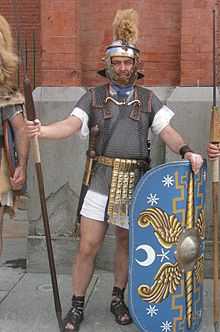Lorica hamata

 | ||||
| Part of a series on the | ||||
| Military of ancient Rome | ||||
|---|---|---|---|---|
| Structural history | ||||
|
||||
| Campaign history | ||||
| Technological history | ||||
|
||||
| Political history | ||||
|
|
||||
| Strategy and tactics | ||||
|
||||
| Military of ancient Rome portal | ||||

The lorica hamata is a type of mail armour used by soldiers of the Roman Republic and the Roman Empire. During the 1st century AD it was starting to be supplemented by lorica segmentata, but had been reintroduced as sole standard-issue armour by the 4th century AD. It was issued to both primary legionary and secondary auxilia troops and was mostly manufactured out of bronze or iron. It comprised alternating rows of closed washer-like rings punched from iron sheets and rows of riveted rings made from drawn wire that ran horizontally, producing very flexible, reliable and strong armour. Each ring had an inside diameter of about 5 mm, and an outside diameter of about 7 mm.
The shoulders of the lorica hamata had flaps that were similar to the Greek linothorax which ran from about mid-back to the front of the torso, and were connected by brass or iron hooks which connected to studs riveted through the ends of the flaps. Up to 30,000 rings would have gone into one lorica hamata, and the estimated production time was two months, even with continual slave labor at the state-run armouries.
The Romans’ knowledge of mail manufacture may have come from third century BC conflicts with the Celts, though the first documented use occurred during the Roman conquest of Hispania. There were several versions of this type of armour, specialized for different military duties such as skirmishers, cavalry and spearmen.
Although labor-intensive to manufacture, it is thought that, with good maintenance, the armour could be used for several decades. Constant friction kept the rings of the lorica hamata free of rust, unlike the lorica segmentata, which needed constant maintenance to prevent corrosion.
Over its lifetime, lorica hamata remained in constant use by legionaries and it was the preferred armour of centurions, who favored its greater coverage and lower maintenance. The lorica hamata was still common amongst the legionary soldiers in the 2nd century AD, despite the use of the more popularly recognized lorica segmentata segmented plate armour. Lorica segmentata was eventually discontinued in the third century AD for unknown reasons, but lorica hamata remained common for both legionaries and auxiliaries. Later versions had sleeves and covered the legs to the knees.
See also
External links
| Wikimedia Commons has media related to Lorica hamata. |